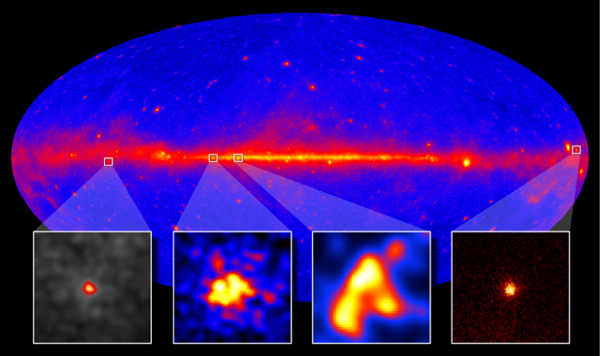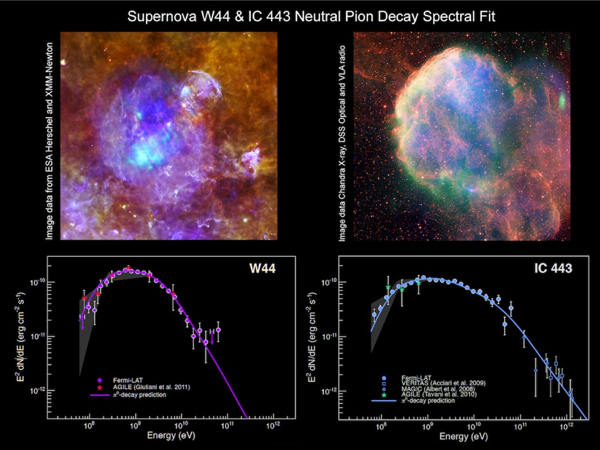New Insights into SNRs from Fermi
Supernova remnants (SNRs) are the result of some of the most powerful explosions in the Universe, and they have great impact on their host galaxies, especially on their chemical enrichment and evolution. SNR shocks interact with the surrounding medium, heating and compressing it, as well as accelerating particles to relativistic energies. Hence, the study of SNRs allows scientists to understand a variety of issues of great importance in astrophysics - the mass loss history of their progenitor stars, the nature of stellar collapse, and the mechanism behind the production of cosmic rays (CRs) from within our Galaxy. To date, observations by Fermi's Large Area Telescope (LAT) have firmly identified gamma-ray emission from 10 SNRs. More than 50 additional candidate associations have been studied individually and/or have been listed in the Fermi-LAT catalogs.

SNRs and Cosmic Rays with the LAT
Cosmic rays have represented a puzzle for astrophysicists since they were first detected more than 100 years ago. These extremely energetic particles are made up of mostly protons and heavier ions (hadrons). Observations suggest that they belong to two broad classes; particles accelerated within the Milky Way dominate the spectrum up to a break in the spectral distribution known as the "knee" (E ~ 1015 eV), and CRs with an extra-Galactic origin appear to prevail at higher energies.
The energetics of SNRs suggest that particle acceleration at their shock boundaries could explain the origin of the Galactic CRs, and this is broadly accepted to be the case. Observations of TeV gamma-ray emission from some SNRs support the scenario where particles are being accelerated to energies approaching the CR "knee" in SNR shocks. It has proven difficult to determine, however, whether these high-energy photons result from emission mechanisms that are leptonic in origin (radiation from inverse Compton scattering or non-thermal bremsstrahlung of low-mass relativistic electrons), or from hadronic emission (high-mass relativistic hadrons interacting with the ambient medium). Gamma-ray observations with Fermi-LAT explore a part of the spectrum that can be used to distinguish between leptonic and hadronic emission (see figure below).

The interaction of CRs with regions of high-density gas and dust in the galaxy is expected to result in gamma-ray emission from the decay of neutral pions generated by proton-proton interactions. The spectral signature of this emission process is characterized by a sharp rise in the ~ 70 - 200 MeV range, and then a spectrum that traces the parent accelerated ion population above ~ 1 GeV. Several studies of gamma-ray emission from SNRs IC443 and W44 have identified the gamma-ray emission as predominantly hadronic in origin using this specific spectral feature. These studies have finally established that hadrons are indeed accelerated to CR energies in SNR shocks.



